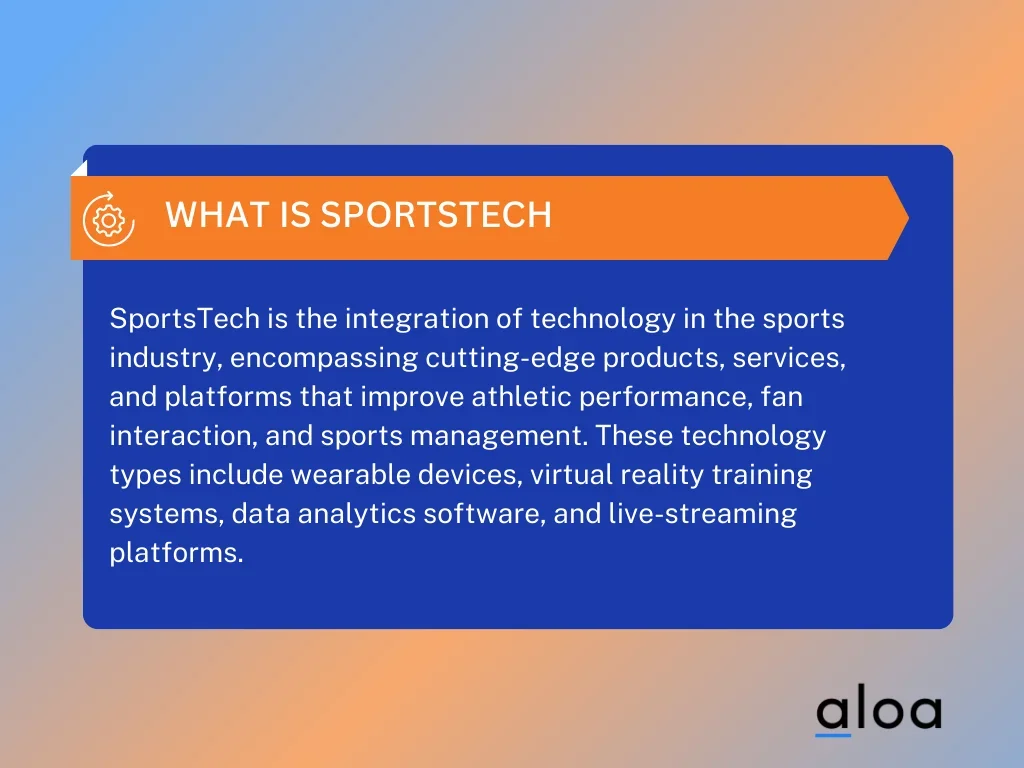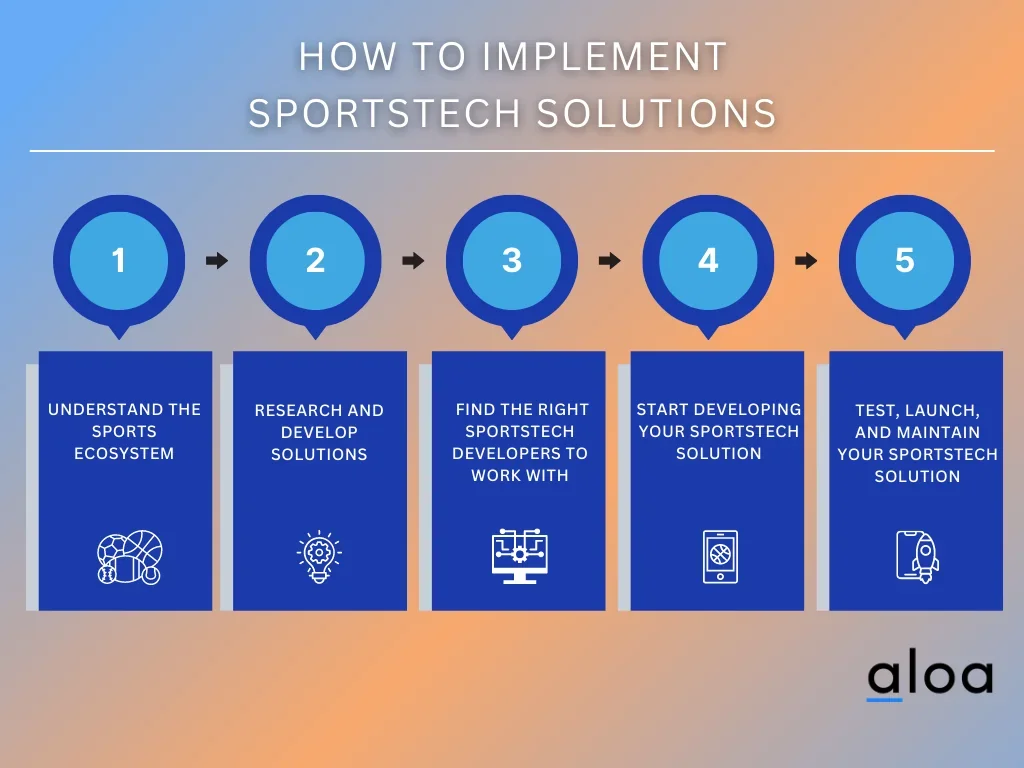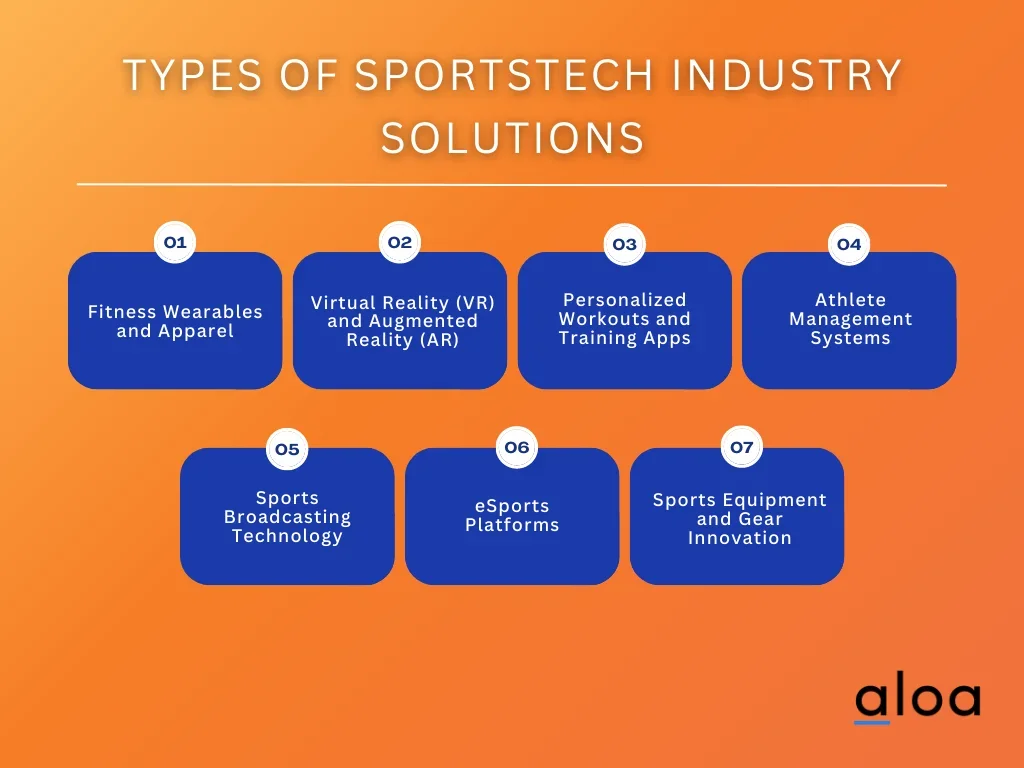The SportsTech industry is experiencing unprecedented growth, with the worldwide market expecting a compound annual growth rate (CAGR) of 20.8% from 2023 to 2030. This exciting technology field leverages mobile and cloud computing advances to revolutionize how athletes train, manage their health and performance, and even watch sports.
As a software development outsourcing company, Aloa stays ahead of the curve in the sports tech industry. We specialize in building custom solutions for clients that use machine learning, analytics, and artificial intelligence to gain an edge over the competition. Our team of experts has experience developing applications from various platforms, including iOS and Android devices and web-based software solutions.
In this blog, we'll share our insights about the SportsTech industry, the key sectors included, how to start implementing SportsTech solutions, and what to expect from the industry. Afterward, you'll have an investor mindset going into the ever-evolving world of SportsTech and be able to capitalize on opportunities as they come up.
Let's get started!
What is SportsTech?

SportsTech is the integration of technology in the sports industry for example triathlon sport, encompassing cutting-edge products, services, and platforms that improve athletic performance, fan interaction, and sports management. These technology types include wearable devices, virtual reality training systems, data analytics software, and live-streaming platforms.
With modern solutions, SportsTech transforms areas such as athlete training, fan experiences, and industry operations. The potential of this burgeoning field is far-reaching, from improving injury prevention to making the sports viewing experience more immersive and interactive.
Apart from that, SportsTech also focuses on giving players and teams access to the latest tools that can help them improve their performance, analyze data, and gain an edge in the sporting arena. It also provides fans a more immersive experience through enhanced audio/visuals, interactive content, and personalized experiences.
Using AI-driven technologies, companies working in the sports tech industry are creating new products and services to help athletes become faster, stronger, and more strategic. With predictive analytics and data-driven insights, teams can make informed decisions that drive success on the field.
Key SportsTech Sectors
The SportsTech industry focuses its innovations on creating an engaging and immersive sports experience for professionals and consumers alike. As the trends of SportsTech grow to the mainstream, various sectors within SportsTech are emerging. Here's a look at some of these key sectors:

Wearable Tech and Performance Tracking
Wearable technology and performance-tracking devices play a crucial role in the training and performance of athletes and sports enthusiasts. These devices, such as fitness trackers, smartwatches, and GPS trackers, provide valuable data on heart rate, speed, and distance performance indicators.
These devices use the gathered data to analyze users, identify trends, track progress, and improve their training regimes. The SportsTech industry, focusing on innovation and improving user experience, continues to develop cutting-edge features in wearable technology and performance-tracking devices.
Sports Data and Statistics
Sports data and statistics focus on providing professional athletes, coaches, and fans with state-of-the-art analytics into the performance of teams and players. Analytics-focused SportsTech includes comprehensive data on player performance, team strategies, and sports analytics.
These technology types revolutionize how professional teams and athletes train, play, and compete. Today, the industry breaks down sports data and statistics technology into two key segments: Professional Athletics and Consumer Sports.
- Professional Athletics: Focuses on providing technology solutions to sports teams, leagues, athletes, and organizations that enable them to optimize performance, manage data better, reduce the risk of injury, collaborate more effectively with their fans, and improve the viewing experience.
- Consumer Sports: Focuses on providing technology solutions to the individual consumer, such as wearable fitness trackers, virtual reality sports experiences, and interactive fitness apps. This sector also includes companies specializing in creating fan-engagement platforms and streaming sports content.
Fan Engagement and Experience
Fan engagement experiences cover SportsTech innovations like virtual reality, interactive content, and games. The design of fan engagement technology enhances the traditional sports viewing experience by making it more immersive and engaging for fans.
SportsTech companies in this sector focus on creating innovative ways for fans to interact and engage with their favorite teams and athletes. Engagement includes giving them access to exclusive content, personalized experiences, live streaming capabilities, and interactive features.
With more people looking to stay connected with their favorite sports teams and athletes from the comfort of their own homes, SportsTech companies are looking for ways to make fan engagement more meaningful.
Creating a holistic fan engagement experience also means innovating live events by updating traditional stadiums into smart stadiums. Smart stadiums incorporate and come equipped with SportsTech sensors and technology that help people navigate the stadium, keep track of seating availability, and even order food and beverages.
eSports and Gaming
eSports and Gaming SportsTech, such as SportsBetting Apps, Fantasy Sports Platforms, and eSport Games, are revolutionizing how people watch and engage with sports. SportsBetting apps give people the opportunity to wager on sporting events in a more secure and transparent manner. These platforms also give users access to real-time data and statistics that help them make informed betting decisions.
Fantasy Sports Platforms allow users to create fantasy teams and compete with friends or other players in tournaments, leagues, and challenges. Professional teams and casual gamers use tech in fantasy sports platforms to gain a competitive edge in the gaming world.
eSports Games are revolutionizing the gaming industry by providing people with an immersive virtual reality experience that allows them to become part of the action. With eSports, professional athletes, teams, and organizations can host tournaments and leagues that draw in fans from around the world.
Altogether these key sectors in the SportsTech industry are enabling athletes, teams, and fans to experience sports in an entirely new way.
How To Implement SportsTech Solutions
Implementing SportTech industry solutions requires a thorough understanding of who will use your solution, what problem it solves, and how your product fits into the larger sports ecosystem. Remember that there are multiple streams to the SportsTech industry, and knowing what type of solution you are building and for whom will help you create a successful product.
Knowing that here are the steps to follow when developing SportsTech industry solutions:

Step 1: Understand the Sports Ecosystem
The sports ecosystem is complex, so it's essential to understand how your product fits into it before taking any further steps. Knowing who uses your solution and what problem it solves will also help you identify the type of SportsTech solution you are creating. You can accomplish this step by learning how to scope a software project.
As mentioned earlier, SportsTech has two main target markets: Professional and Consumer. Athletes, sports teams, leagues, and organizations use professional products. At the same time, consumer-focused SportsTech solutions are geared toward individual users.
Determining who your solution is tailored for will help you create a product that meets the needs of that specific target market. As an example, professionals in the industry may need a product that provides them with real-time analytics, while consumers may need more of a social engagement platform.
After identifying your target market, the next step is to determine what problem you are solving for them. Some common problems in the sports tech industry include reducing the risk of injury, improving player performance, and engaging with fans. Knowing the problem you are solving can help you develop a solution that will be successful in the market.
Taking the time to specify what problem you want to solve and for whom will help you create a product tailored to your target market's needs. Dedicating effort to the process also gives you a better chance of creating a minimum viable product (MVP) that resonates with people.
Step 2: Research and Develop Solutions
Once you have identified your target market and problem, it's time to start researching potential solutions. Look for existing SportsTech industry trends as well as innovations. When choosing the right technology for your SportsTech solution, it is important to consider its capabilities and cost.
Depending on what type of product you are creating, you may need a combination of features and capabilities. Research and compare different technologies before deciding which one to use.
It's also essential to break down what you want your product to do into smaller chunks of work so that you can divide it among different team members. This will help streamline the development process and increase productivity.
Step 3: Find The Right SportsTech Developers To Work With
SportsTech development is a highly specialized field, and the right development team can make or break your product. Before you start looking for developers, it's essential to have a clear idea of what solution you need and what skills it requires.
Once you have identified the type of developer you need, look for candidates who specialize in SportsTech development. Look at their past projects and assess if they fit your team well. It's also important to look at their reviews and ask to speak with references before hiring.
With the right development team in place, you can ensure that your product is delivered on time and up to standard.
Step 4: Start Developing Your SportsTech Solution
Whether it's an analytics platform, a fan engagement experience, or an eSports gaming platform- taking the time to develop and design your product is essential. Creating a successful SportsTech product means understanding your problem and researching existing solutions.
Taking the time to delve into the sports tech industry will give you a better understanding of what it takes to create an effective product. Starting development also means outlining what features the product needs, testing different product versions before launch, and getting user feedback.
Doing these things will ensure that you have a successful product that resonates with people in the industry. During this stage, make sure to keep in mind your UX/UI design and user experience. This is key to providing people with an enjoyable experience when using your product.
Step 5: Test, Launch, and Maintain Your SportsTech Solution
It's essential to take the time to test your product before launching it to ensure that all features are working correctly and that there are no bugs. Once you have tested your product and everything is running smoothly, you can launch it on the market.
Finally, maintenance should be a top priority once you have launched your product. Even after your product is in the market, you should continue to monitor it and ensure everything is running smoothly. It's also important to keep up with industry trends and update your solution to stay competitive.
Types of SportsTech Industry Solutions
SportsTech encompasses a wide range of solutions that are transforming the way we experience sports. The different types of SportsTech solutions include:

Fitness Wearables and Apparel
Fitness wearables and apparel help athletes track their performance, monitor their health, and improve their overall fitness. This sector includes fitness trackers, sports apparel with embedded sensors, and connected shoes.
Wearable technology, an emerging field in the sports industry, encompasses a wide range of devices like fitness trackers, smartwatches, and heart rate monitors. Athletes can utilize these devices to access real-time performance data, such as heart rate, distance covered, and calories burned.
This information serves as a valuable tool for monitoring progress, setting targets, and making improvements. Furthermore, the data collected from wearable technology enables in-depth analysis to identify trends and patterns, empowering athletes to optimize their training strategies and achieve peak performance.
Virtual Reality (VR) and Augmented Reality (AR):
Virtual Reality (VR) and Augmented Reality (AR) offer immersive experiences for athletes and fans alike. VR immerses users in virtual sports environments, while AR overlays digital info onto the real world. These technologies benefit training, coaching, fan engagement, and broadcasting.
Athletes refine skills through realistic simulations, while fans enjoy interactive viewing, real-time statistics, and more. The future of sports tech incorporates VR and AR, shaping a new era of sports experiences.
Personalized Workouts and Training Apps
Personalized workouts and training apps help athletes customize their fitness plans according to their own goals and abilities. This sector includes products such as online workout programs, digital personal trainers, and AI-driven health coaches.
Performance analytics, a vital aspect of the sports tech industry, employs cutting-edge algorithms and machine learning to analyze data from wearables, video analysis, and biometric sensors. It tracks important metrics like speed, distance, heart rate, and technique, enabling coaches and trainers to gain valuable insights for optimizing athlete performance.
This technology plays a significant role in professional sports teams and individual training programs across various organizations. In the rapidly evolving world of sports tech startups, performance analytics continues to be a game-changer, empowering sports organizations to make data-driven decisions and maximize results.
Athlete Management Systems
Athlete management systems have emerged as game-changers in the sports industry, transforming the way sports organizations, coaches, and trainers optimize performance and monitor athletes' well-being.
These cutting-edge software platforms, utilized by startups and established sports tech companies, offer many features, including data tracking, performance analysis, injury prevention, scheduling, and communication tools. By implementing athlete management systems, sports organizations can centralize athlete data and gain valuable insights to make informed decisions.
These systems have succeeded in various sports, from professional leagues like the Premier League to individual athletes seeking performance enhancement. With the increasing prominence of sports analytics, athlete management systems have become a crucial component of the sports tech ecosystem.
Sports Broadcasting Technology
Advancements in sports broadcasting technology have revolutionized the way fans consume sports content. The tools and systems used to capture and distribute sports content have evolved from cameras to streaming platforms.
Now, fans can enjoy immersive viewing experiences and have instant access to live events. Integrating virtual reality (VR) and augmented reality (AR) technologies has expanded the possibilities for fan engagement.
These technologies offer new ways to experience the game and provide unique perspectives on the action. Whether watching a live match or exploring behind-the-scenes content, sports broadcasting technology continues to enhance the overall sports experience.
eSports Platforms
ESports platforms have rapidly gained popularity in the sports industry, attracting startups and established sports organizations. These platforms, also known as sports tech accelerators, provide online spaces for gamers to compete in various games.
With features like leaderboards, matchmaking systems, and live streaming capabilities, esports platforms have created a thriving community of competitive gamers. The rise of esports has caught the attention of major players in the sports industry, such as NBC Sports and premier leagues in Europe.
This growing sector within the sports business has also paved the way for innovative analytics tools and technologies tailored specifically for esports.
Sports Equipment and Gear Innovation
The SportsTech industry constantly pushes the boundaries of sports equipment and gear innovation. With a focus on enhancing athlete performance, ensuring safety, and providing a superior sporting experience, startups, and sports organizations are developing cutting-edge solutions.
From advanced materials that are lighter, stronger, and more durable to smart wearable devices that track performance metrics, such as heart rate and distance traveled, sports technology transforms how athletes train, compete, and achieve their goals.
Through analytics and data-driven insights, these innovations are revolutionizing the sports business and shaping the future of sports tech.
The Future of SportsTech
The SportsTech industry will continue to evolve toward a more connected, data-driven future. With AI and machine learning technology driving sports experiences, coaches and athletes can leverage powerful insights to enhance performance. At the same time, fans are provided with a more immersive viewing experience.
With the expected growth the industry is expected to realize, it's an excellent time for entrepreneurs, innovators, businesses, and startups to invest their resources and ideas into the sports tech industry. The future of sports tech looks bright, and as technology advances, so will the opportunities to impact the world of sports in meaningful ways.
Key Takeaway
The SportsTech industry has experienced tremendous growth and disruption in recent years, with innovative solutions emerging to enhance athlete performance, safety, and fan engagement.
Companies of all sizes in the industry are embracing the power of data-driven analytics, allowing sports organizations to make informed decisions while providing fans with an immersive viewing experience.
The future of SportsTech looks bright as entrepreneurs continue investing their resources and ideas into this rapidly evolving industry. With the right team, technology, and vision, there is immense potential to make a meaningful impact in the age of sports tech.
If you're ready to leverage the potential benefits of SportsTech, now is the time to take action. Reach out to [email protected] for insights and comprehensive solutions designed to enhance performance and maximize results that bring your ideas and investments to the next level.

